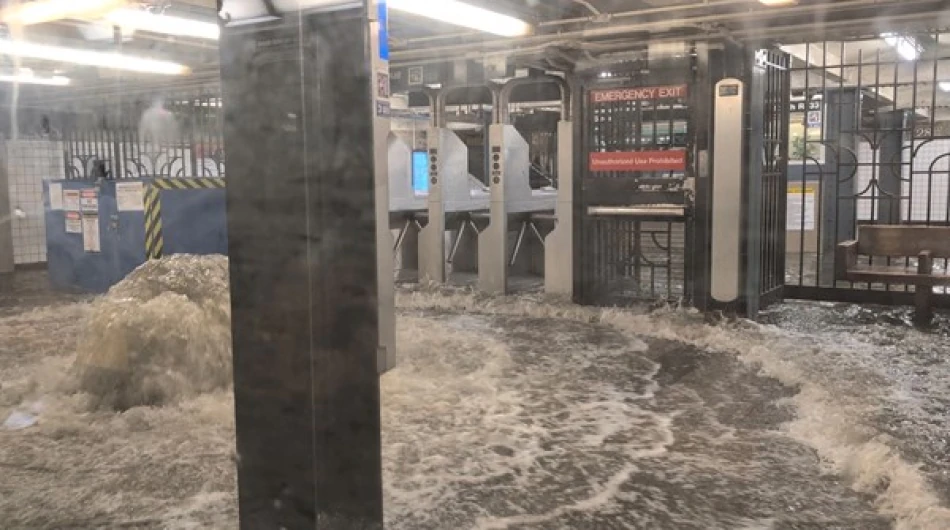
Extreme Floods Devastate New York and New Jersey: A Powerful Natural Disaster Unfolds
Unprecedented Flash Floods Paralyze New York Metro Area as Climate Reality Strikes America's Economic Heart
A severe storm system unleashed record-breaking rainfall across New York and New Jersey overnight Monday into Tuesday, triggering widespread flooding that shut down major airports, crippled subway systems, and forced emergency declarations across multiple states. The deluge—which dumped up to 150mm of rain in some areas within hours—represents another stark reminder of how extreme weather events are increasingly disrupting critical infrastructure in America's most densely populated corridors.
Transportation Networks Collapse Under Nature's Assault
The economic implications became immediately apparent as three major airports—John F. Kennedy, LaGuardia, and Newark—suspended departures, stranding thousands of passengers and disrupting global air traffic patterns. The ripple effects extended far beyond the tri-state area, as these hubs handle nearly 130 million passengers annually and serve as critical gateways for international commerce.
New York's subway system, the lifeblood of the city's $1.8 trillion economy, suffered severe disruptions with multiple lines shuttered and stations flooded, particularly in Chelsea and Lower Manhattan. These areas house major financial institutions and tech companies, effectively cutting off hundreds of thousands of workers from their offices during peak business hours.
Infrastructure Vulnerability Exposed
The flooding revealed critical weaknesses in urban drainage systems that were designed for a different climate reality. Saturated soils and overwhelmed storm drains amplified the crisis, turning streets into rivers and paralyzing major thoroughfares. This infrastructure failure pattern mirrors similar events in other major metropolitan areas, from Houston's Hurricane Harvey experience to European cities grappling with unprecedented rainfall.
Multi-State Emergency Response Mobilizes
New Jersey Governor Phil Murphy's emergency declaration across multiple counties underscored the regional scope of the crisis. The directive for residents to shelter in place reflected authorities' recognition that traditional emergency response protocols are increasingly inadequate for rapid-onset extreme weather events.
The National Weather Service extended flood warnings until 7:15 AM local time, with impacts spreading across Virginia, Maryland, and Pennsylvania. Central Virginia remained under emergency flood conditions, demonstrating how localized weather systems can cascade across vast geographic areas.
Record-Breaking Rainfall Patterns
Meteorological data revealed the storm's extraordinary intensity: New York neighborhoods recorded 38-45mm of rainfall in under two hours, while New Jersey saw accumulations reaching 150mm. These figures represent the type of extreme precipitation events that climate scientists have long predicted would become more frequent and intense.
Economic and Social Implications
The absence of reported casualties, while fortunate, masks the broader economic disruption. Major corporations likely faced significant productivity losses as employees couldn't reach offices, while small businesses in affected areas confronted immediate revenue impacts and potential property damage.
The timing—during a typical business day—highlighted urban America's vulnerability to climate-related disruptions. Unlike hurricanes, which provide days of advance warning, flash flooding events offer little preparation time, making them particularly challenging for emergency management and business continuity planning.
Recovery and Resilience Challenges
As the storm system moved eastward Tuesday, authorities emphasized continued vigilance. Transportation networks remained partially disrupted, requiring extensive maintenance and repair operations. This recovery phase often proves more costly and time-consuming than the initial emergency response, as infrastructure damage assessments reveal the full scope of needed repairs.
The event serves as another data point in the growing catalog of extreme weather impacts on major urban centers, reinforcing the urgent need for infrastructure modernization and climate adaptation strategies in America's most economically vital regions.
Most Viewed News

 Layla Al Mansoori
Layla Al Mansoori






